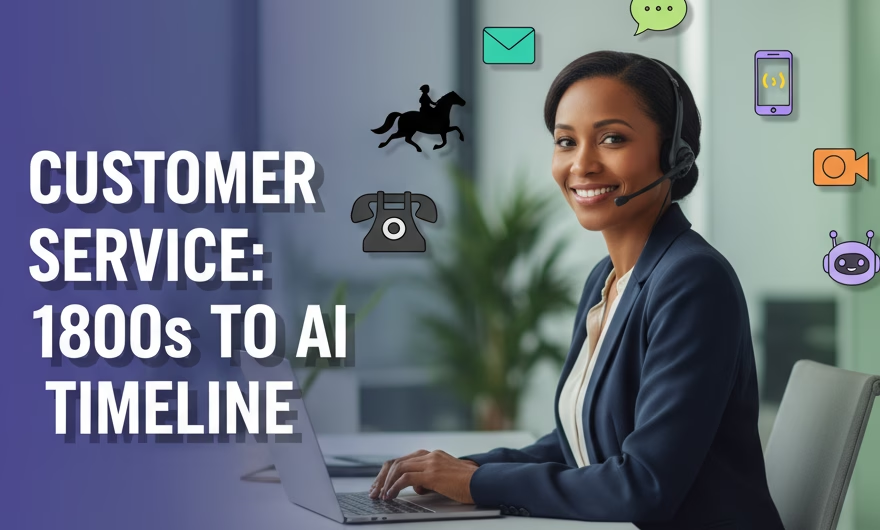The customer service scenario has not always been as sophisticated as it is today. Like everything else, it has evolved over time, shaped by emerging technologies and changing consumer expectations. What began as face-to-face problem solving has become an always-on, omnichannel discipline where speed, empathy, and personalization are the norm. If you’ve ever wondered how it all started and where we’re headed, this overview will guide you through the key milestones in the history of customer service, highlighting how each era laid the groundwork for the next.
“What began as face-to-face problem solving has become an always-on, omnichannel discipline where speed, empathy, and personalization are the norm.”
Early 1800s – Reach the Seller
In the early 1800s, the only way to reach a seller or resolve an issue with a product was to visit them in person. This often meant long journeys—by train or even on horseback—just to find out if a problem could be fixed. The process was time-consuming, with multiple trips often required to complete a resolution.
In this period, commerce was highly local and relationships were personal. Reputation and trust were the primary “systems” for service. While letters and public notices existed, they were slow and unreliable for resolving product issues. The result: limited reach, delayed resolutions, and a service model defined by proximity. Yet the principle that still guides customer service today—listening to the customer and making things right—was already taking shape.
1876 – Invention of the Telephone
A major turning point came in 1876 with the invention of the telephone. This innovation drastically reduced the time and effort needed to communicate with businesses. Customers could now voice their concerns more quickly, and businesses could respond without an in-person visit. The telephone marked the beginning of remote customer service, setting the stage for future advancements.
As telephone networks expanded, businesses organized dedicated teams to handle inbound calls, laying the foundations for the modern contact center. Operator switchboards evolved into formalized call routing, and standard practices emerged—greeting scripts, escalation paths, and call logging. Over time, the voice channel became the backbone of service for order taking, troubleshooting, and support.
Recognizing the importance of the customer service function, the first week in October was officially proclaimed National Customer Service Week in the United States in 1992 by President George H. W. Bush. Celebrated annually ever since, it underscores the role that service plays in sustainable business growth and customer loyalty.
1996 – Email and Live Chat
The mid-1990s brought another leap forward with the advent of email and live chat. These channels allowed customers to reach out in writing, at any time, without the need for a phone call. This was particularly convenient for non-urgent queries and provided a written record of interactions, which helped in tracking and resolving issues more efficiently.
As the web matured, customer service teams adopted helpdesk and ticketing systems to organize requests, assign ownership, and measure response times. Email unlocked new possibilities:
- Asynchronous conversations that fit customers’ schedules
- Clear, searchable histories of prior interactions
- Ability to attach screenshots, logs, or documents for faster diagnosis
- Templates and knowledge bases to deliver consistent answers
Live chat added real-time convenience right on websites, reducing friction in moments of purchase or onboarding. For the first time, customers could ask a question mid-journey and get help without leaving the page—an early step toward today’s integrated, in-context support.
Millennium Onset – Social Media, AI, In-App Chat Support, Video Telephony, and More
The turn of the millennium saw rapid advancements in customer service technology. Over just a few years, businesses began adopting:
- Social media for public and private customer interactions—brands monitor posts, direct messages, and mentions to resolve issues and protect reputation in real time.
- Artificial intelligence (AI) for automated responses and predictive support—chatbots handle common intents, while agent-assist tools surface next-best actions and knowledge suggestions.
- In-app chat support for instant help within mobile and web applications—SDKs and embedded widgets keep conversations contextual and uninterrupted.
- Video telephony for face-to-face virtual assistance—agents can guide customers through complex setups, identity verification, and remote troubleshooting.
These innovations gave customers more power and flexibility in how they sought support. With dedicated mobile apps and on-the-go connectivity, customers could experience service firsthand, anytime and anywhere. Contact centers moved to the cloud, enabling distributed teams, elastic capacity during demand spikes, and tighter integration with CRMs and analytics platforms—hallmarks of an omnichannel contact center.
As of 2025, customer expectations emphasize:
- Speed: Fast, first-contact resolutions across channels
- Personalization: Context-aware service informed by purchase history and prior interactions
- Proactivity: Notifications and interventions before problems escalate
- Choice: Freedom to switch channels—voice, messaging, email, social—without losing context
AI capabilities have advanced from simple keyword matching to natural language understanding and, more recently, generative AI. As of 2025, generative models help draft responses, summarize long histories, translate in real time, and power smarter self-service that feels conversational rather than scripted. Meanwhile, messaging channels—such as SMS, WhatsApp Business, and business messaging on popular platforms—have become core to modern customer care, especially for status updates, two-way conversations, and secure authentication flows.
Behind the scenes, service teams now rely on unified customer profiles, journey analytics, and intent detection to ensure consistent, context-rich experiences. Security and privacy practices have matured as well, with authentication, consent, and data minimization becoming standard considerations in every support flow.
The Road Ahead
The evolution of customer service is far from over. The scope for further advancements remains wide, with untapped potential for technology and innovation. As of 2025, several themes are shaping the future of service:
- Agent + AI collaboration: Real-time “copilot” tools assist agents with suggested replies, dynamic checklists, and policy guidance, improving accuracy and reducing handling time while keeping humans in control.
- Multimodal interactions: Customers will move fluidly between text, voice, images, and video. Visual troubleshooting, document capture, and screen sharing will be increasingly common in complex support scenarios.
- Proactive and predictive care: Telemetry from apps, devices, and services will trigger outreach before customers encounter friction—resetting passwords, renewing subscriptions, or averting service disruptions.
- Smarter self-service: Conversational experiences that understand intent, remember context, and escalate gracefully will resolve more issues without a handoff to live agents.
- Omnichannel continuity: Conversation state will persist across channels, so customers can start on chat, continue on voice, and finish via email without repeating themselves.
- Trust and compliance by design: Strong verification (including voice or device signals), explicit consent flows, and secure data handling will remain non-negotiable as automation expands.
Equally important is the human element. Empathy, clear communication, and accountability remain the differentiators that technology amplifies but cannot replace. Training will evolve to include AI literacy, journey thinking, and scenario-based problem solving, ensuring teams can handle edge cases and emotionally charged moments with care.
Empathy, clarity, and accountability—amplified by trustworthy automation—will define service excellence in the years ahead.
Closing Thoughts
Customer service has come a long way from the days of horse-drawn journeys to instant, omnichannel support. Each era—telephony, email and chat, social and mobile, AI and video—introduced new capabilities that shortened the distance between question and answer, and between intent and outcome. The journey reflects not just technological progress but also a deeper understanding of customer needs and the value of building lasting relationships.
As we look to the future, one thing is clear: the pursuit of better customer service is a journey without end. Organizations that blend human empathy with trustworthy automation, keep conversations connected across channels, and act proactively will set the standard for service excellence in the years ahead.
If you have any feedback to share or points to add, let me know in the comments section. I’d love to hear from you!




